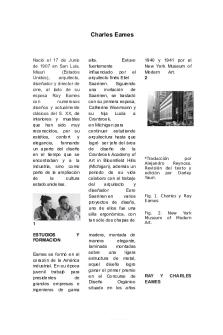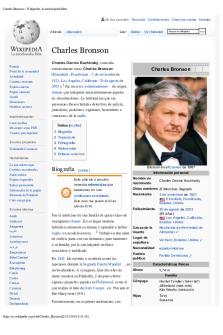Intelligence - Alfred Binet, H.H Goddard, Robert Yerkes, Cyril Burt, Charles Spearman, Howe, PDF

| Title | Intelligence - Alfred Binet, H.H Goddard, Robert Yerkes, Cyril Burt, Charles Spearman, Howe, |
|---|---|
| Course | Cognition |
| Institution | University of Lincoln |
| Pages | 7 |
| File Size | 180.6 KB |
| File Type | |
| Total Downloads | 92 |
| Total Views | 126 |
Summary
Alfred Binet, H.H Goddard, Robert Yerkes, Cyril Burt, Charles Spearman, Howe, Influences, Steele and Aronson, Sternberg, Kaleidoscope project...
Description
Intelligence Alfred Binet – Trying to help those in need Wanted to identify children needing special education Solution o Lots of different short tasks o Individual testing by trained examiners Test used to determine child’s mental age o E.g. a 7 year old who passes the 6 yr old test but fails 7 yr old test is given a mental age of 6 Children with mental age significantly under their own = special education required Stren 192 – IQ = Mental Age / Chronological age x 100 Binet’s fears Intelligence too complex to capture in a single number Reified as if a real entity Assumes it can’t be changed rather than to identify need for help Assume intelligence inborn Self-fulfilling prophecy Used to rank ALL children rather than just identify less able H.H. Goddard Hereditarian o Intelligence is innate and unchangeable o No special education could ever help Part of Eugenics movement Which argued for improving US genetic ‘stock’ through o Euthanasia o Sterilisation o Immigration restriction o Outlawing miscegenation (racial intermarriage) He invented the ‘moron’ o Under ‘normal’ range of IQ o Previously If you can’t learn to speak – idiot If you can’t learn to write – Imbecile Argued for confining and sterilising morons Tested 152 immigrants on Ellis Island o Italians, Hungarians, Jews, Russians
Italians: 79% morons Hungarians: 80% morons Jews: 83% Morons Russians: 87% Morons
Robert Yerkes The Army tests o Testing of WW1 recruits Hereditarians created IQ tests – Goddard, Terman etc Two test versions o Army Alpha: written exam for literates o Army Beta: Pictorial exam for illiterates o Individual: Recalled for testing alone Army probably didn’t much use the results Real use: data on 1.5m men Popularised results of army testing: o Average mental age: 13 years Logically absurd Graded EU immigrants by mental age Placed the ‘Negro’ at the bottom BUT Alpha and Beta tests were not equivalent o Black people and immigrants rarely were given the Alpha Beta didn’t require literacy but did require: o Holding a pencil Some had never held a pencil before o Recognising and understanding numbers In 3/7 Instructions were different o Alpha WAYYYYY more detailed Things that could affect scores o Literacy o Numeracy o Attention o Reassurance & explanation o Anxiety o Perseverance o Self-confidence Sir Cyril Burt A lot of fraud Twin studies mainly
Identical twins reared apart o This would support hereditary over environment Fraud o Originally studied 20 pairs -> eventually studied 50 pairs but correlation stays same to 3 decimal places (statistically impossible) o Made up 2 ‘collaborators’ Tried to rewrite history so HE was the father of factor analysis, not Spearman
Charles Spearman g for General Intelligence Correlation of IQ tests Invented factor analysis o Correlations between lots of things rather than just pairs Found o High correlations between scores on different IQ tests Argued IQ is made up of 2 parts o Common properties across all the intelligence tests – g – General Intelligence o Non-common aspects of each test s – Specific information Spearman’s g used to support hereditarian view Reifications of IQ as a biological entity – Intelligence is a THING
Other reasons for high correlation between tests – Howe 1997 o Doing well: Self confidence Competitiveness Show-offiness o Doing badly: Threatened by tests Tests irrelevant Culture: don’t put yourself forward
Don’t believe yourself “unintelligent” o Beliefs Self-efficacy: IQ not set - I can improve! o Cognitions Adler: Are your ‘Guiding Fictions’ unhelpful? o Motivation Maslow: Are lower needs distracting you? o Exposure Immerse yourself in psychology
o Practice General study skills Writing skills Research skills etc. Can IQ be increased? No
Hereditarians argued: o Environmental influences don’t change IQ o Schooling doesn’t change IQ o Attempts to raise IQ failed o Attempts are temporary
Howe 1997 1998 Demonstrates IQ has been increased o Adoption studies o Intervention studies o More schooling o Generational changes o Motivational influences o Training on IQ tests Adoption studies Deprived kids were put into middle class homes o Average IQ gain of 20 IQ points above biological parents and siblings o Capron & Duyme 1989 Intervention studies o Project head start (1960) Varied length and organization o Many impressive increases in IQ Zigler & Muenchow 1992 – 10 IQ points in one summer More schooling = higher IQ Generational changes The Flynn Effect IQ tests ‘re-standardised’ over the years o To keep the average at 100 Flynn 1999 looked at real improvements of IQ between generations o We have all become more intelligent over time Motivational influences Can affect IQ scores
Johnson, Bradley-Johnson, McCarthy & Jamie (1984) Gave black inner city kids tokens for toys for each correct test answer Raised IQ scores by 13 points Sinnott, Hilton, Wood, Spanos and Toel 2016 o Tested undergraduates o Found significant positive correlations Motivation & overall IQ Motivation & verbal IQ Motivation & performance IQ
Stereotype threat Steele and colleagues Groups being judged & treated stereotypically This affects their performance Stereotyped: Worried about: being judged/treated stereotypically/confirming stereotype: performance interference
Steele and Aronson 1995
Widely replicated IQ/Aptitude test for African American/Hispanic groups Maths ability for women Showed some subtleties: o Ethinc minorities High stakes testing for top jobs and scholarships
Gender o Maths ability not so universally relevant to hiring Implicit vs explicit threat cues o Implicit E.g. just priming group membership or emphasising that test is diagnostic o Explicit E.g. actually telling them their group does poorly on the test Identification – how far self esteem is tied up with what the test tests o High vs low identification
Sternberg (2015) Argued that standard IQ tests too narrow to predict success o At university o In life Proposed also testing o Creative skills o Producing new ideas Analytical skills o Evaluating ideas o Practical skills o Putting ideas into practice & convincing others o Wisdom-based skills o Using knowledge/skills for good
Rainbow Project Kaleidoscope Project
Rainbow project 13 US colleges (N=793) Used the usual o Standardised tests e.g. stats o Grade Point Average (GPA) Plus o Additional tests of Creative, analytical and practical skills o Using unusual response formats, e.g. Navigate through a map Write a short story Dealing with a problem in a video scenario Findings o In simple correlations, SATs/GPA/Rainbow all predict Year 1 GPA
But more complex analysis showed o Only high school HPA predicted UG GPA on its own o But prediction doubled if added in rainbow measures compared to SATs o Plus, rainbow measures shrank ethnic group differences
Kaleidoscope project Sternberg became Dean of Arts & Sciences at Tufts University From 2006 to time of publication (2015) o 15,000 students per year Usual tests/measures, plus o Essay (optional) Assessed for Creative, Analytical & Practical skills and for Wisdom o Other evidence of creativity E.g. Portfolio, prizes/awards Findings o Year 1 Half completed essay o Since then 2/3 complete essay Quality of essay/other Kaleidoscope measures o Improved chance of admission A for Kaleidoscope measures = twice chance of admission compared to non-A Plus o Ethnic differences disappeared!...
Similar Free PDFs

KORELASI RANK SPEARMAN
- 8 Pages

Syllabus - Ian Howe
- 13 Pages

Howe 2 ski motivation essay
- 2 Pages

Alfred agache
- 14 Pages

Reading 1 ALFRED
- 2 Pages

Charles Perrow - ....
- 2 Pages

Charles Eames
- 5 Pages

Charles Bronson
- 6 Pages

1. Alfred Adler
- 1 Pages

TEORÍA DE ALFRED ADLER
- 2 Pages

Week 6 – Alfred Marshall
- 10 Pages

Individual Psychology (Alfred Adler)
- 15 Pages
Popular Institutions
- Tinajero National High School - Annex
- Politeknik Caltex Riau
- Yokohama City University
- SGT University
- University of Al-Qadisiyah
- Divine Word College of Vigan
- Techniek College Rotterdam
- Universidade de Santiago
- Universiti Teknologi MARA Cawangan Johor Kampus Pasir Gudang
- Poltekkes Kemenkes Yogyakarta
- Baguio City National High School
- Colegio san marcos
- preparatoria uno
- Centro de Bachillerato Tecnológico Industrial y de Servicios No. 107
- Dalian Maritime University
- Quang Trung Secondary School
- Colegio Tecnológico en Informática
- Corporación Regional de Educación Superior
- Grupo CEDVA
- Dar Al Uloom University
- Centro de Estudios Preuniversitarios de la Universidad Nacional de Ingeniería
- 上智大学
- Aakash International School, Nuna Majara
- San Felipe Neri Catholic School
- Kang Chiao International School - New Taipei City
- Misamis Occidental National High School
- Institución Educativa Escuela Normal Juan Ladrilleros
- Kolehiyo ng Pantukan
- Batanes State College
- Instituto Continental
- Sekolah Menengah Kejuruan Kesehatan Kaltara (Tarakan)
- Colegio de La Inmaculada Concepcion - Cebu



